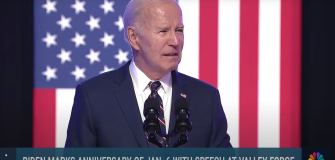Polls that show Trump winning are wrong, Biden team says
Share

Democrats have a response to a fresh batch of national polls showing President Joe Biden trailing in his reelection bid to former President Donald Trump: denial.
That’s not a universal sentiment within the party. Many Democrats are alarmed by these numbers, even eight months out from the election. Biden’s age, the direction of the campaign, inflation, and the lack of a competitive primary process have long been subjects of concern.
But in public, Biden’s campaign downplays the polls, and many liberals agree.
“Polling continues to be at odds with how American votes and consistently overestimates Donald Trump while underestimating President Biden,” Biden campaign communications director Michael Tyler said in response to the recent numbers. “Whether it’s in special elections or in the presidential primaries, actual voter behavior tells us a lot more than any poll does, and it tells a very clear story: Joe Biden and Democrats continue to outperform, while Donald Trump and the party leaders are weak, cash-strapped, and deeply divided.”
In a long New Yorker piece about Biden’s defiance in the face of the polls, an aide is quoted as saying of the president, “He is not diverted by politics or by bad polling or by some crazy-ass s*** that Donald Trump has done.”
Politico quoted one Democrat as warning the party, “This should be a wake-up call that things have to improve and change. The reaction can’t be to go all cross-tabs truther on [elections analyst] Nate Cohn or tell people to calm down.”
Yet after years of mostly ignoring the online Left, Biden’s camp and some Democratic social media voices are aligned in poking holes in polls that show major slippage with minority voters, a lack of enthusiasm among the party base, low confidence in the economy, and major concerns about the president’s age.
In the last few days, the New York Times, Wall Street Journal, Fox News, and CBS News have all come out with polls showing Trump ahead of Biden.
This comes on the heels of two polls — one by Emerson College, the other by Bloomberg-Morning Consult — showing Trump sweeping the battleground states. In some cases, Trump’s lead was as big as 6 points.
The national New York Times-Siena College poll was particularly damning, showing Biden less popular than Trump and more people thinking they have been hurt by the current administration’s policies than helped. Nearly every metric was bad news for Biden.
Many Democrats panicked. But others argued the polling is refuted by real-world election results: In the midterm elections and special elections, Democrats have overperformed. And it is the Republican primaries rather than the Democratic contest that shows discontent with the front-runner. Former Ambassador to the United Nations Nikki Haley won the Washington, D.C., primary after winning nearly 40% in South Carolina and actually breaking 40% in New Hampshire.
“Look, 100,000 people voted,” Biden himself told the New Yorker when asked about Trump’s Iowa win. “He got 50% of 100,000 votes.” Evan Osnos, the author of the piece, pointed out that “it was closer to 110,000 votes.”
The polling industry has had its struggles in recent years, plagued by low response rates and the ditching of landlines for cellphones. Figuring out who will actually turn out to vote is always challenging.
In 2012, many Republicans thought it was unlikely that then-President Barack Obama would be able to replicate his millennial and minority support from his historic 2008 campaign as he sought a second term. If he couldn’t, it would mean Mitt Romney stood a better chance of winning than most polls were forecasting.
Republicans called for “unskewing the polls.” Gallup’s final poll had Romney up by 1. The final RealClearPolitics polling average had Obama up by 0.7 points. Obama ended up winning by 3.9 points and an even bigger margin in the Electoral College, no skewing necessary.
Four years later, questions about the polls resurfaced. This time, it turned out the polls were missing some support for the Republican nominee. The numbers weren’t quite so off nationally — the final RealClearPolitics average of 2016 had Hillary Clinton leading by 3.2 points, while she ended up winning the popular vote by 2.1.
But the swing state polls were off, which caused pollsters to miss Trump’s coming win in the Electoral College. Moreover, these discrepancies did skew analysis of the national polls. Clinton’s lead was far less secure if you thought Trump could win Pennsylvania.
Instead, Trafalgar was the only major pollster to show Trump winning Pennsylvania. The same was true for Michigan. No late poll included in the RealClearPolitics average showed Trump winning Wisconsin. He carried all three states and won the election.
Now the Biden campaign finds itself in the position of hoping the 2024 polling is similarly off, though there have been no comparable misfires since. Democrats did survive dismal polling in the midterm elections. But the polls didn’t get the recent special elections wrong, and Republicans won the popular vote in 2022 even as they fell short in some key, winnable races.
“Trump consistently underperforms & Biden overperforms in primaries,” Obama 2012 campaign manager Jim Messina wrote on X. “In NH, Trump 7 pts worse poll v result. In SC -8 points & MI -10 points. Best predictor of elections = how voters vote. And they’re voting for Dems & Biden.”
Campaigns have previously overcome bigger leads than Trump’s. George H.W. Bush was down 17 points to Michael Dukakis coming out of the conventions in 1988. Bush won in November relatively easily, carrying 40 states. Trump is leading by 2 to 4 points much earlier in the campaign. Polls are just a snapshot of public opinion in a moment.
In their public messaging, at least, the Biden campaign is insisting that Trump isn’t really ahead in March 2024 rather than that they can change these numbers by November.
Maybe they are right. Or maybe the conditions that doomed Democrats in 2016 are reappearing now and this time, the pollsters are capturing them.
The main factor that helped Biden beat Trump in 2020, the pandemic, has receded in importance. Since then, public discontent with Biden has simmered among voters the Republicans have yet to be fully successful in turning out, while new dividing lines in the Democratic coalition like the Israel-Hamas war have emerged.
Throw in Robert F. Kennedy Jr., among other third-party candidates, and the race becomes unpredictable for pollsters and campaigns alike.
Continue Reading at The Washington Examiner.













